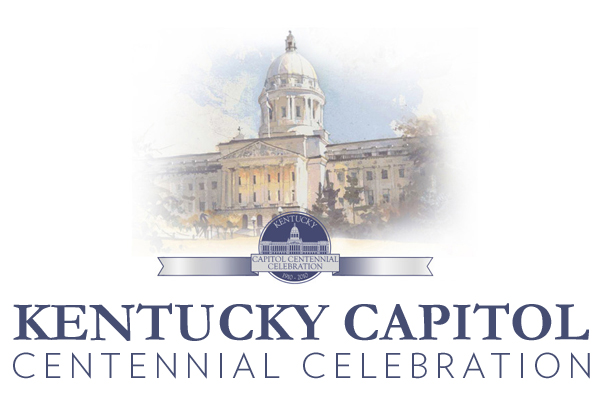
Centennial Legacy Project: Pendentive Murals
Timed to coincide with the Kentucky State Capitol’s centennial celebration on June 4th and 5th 2010, EverGreene Architectural Arts has been commissioned to paint 4 pendentive murals, to be installed in the rotunda of Kentucky’s Statehouse.
When the Capitol Building was originally built, plans were in place for the muralist Frank Millet—a former Harvard classmate of Kentucky’s then Governor August E. Willson—to design and paint the mural pendentive areas. Tragically, Millet died on the ill‐fated maiden voyage of the Titanic on April 14, 1912, and with his passing, plans for murals in the Capitol rotunda were put on hold. Several initiatives to resurrect the murals were proposed in the years thereafter, but the various plans were shelved due to economics of state government.
When EverGreene Architectural Arts performed a restoration of the Kentucky State Capitol’s State Reception Room in 1991, Jeff Greene presented Capitol officials with a sketch of what the Capitol Rotunda could look like with painted pendentive murals. The sketch was put in an attic, and found by chance in 2005 by David Buchta, the former Director and State Curator of the Kentucky Division of Historic Properties.
The Division of Historic Properties subsequently initiated a restoration of the Capitol Rotunda. The planning, logistics, and fundraising took over three years; in the course of this, Mr. Buchta and others realized that the restoration of the rotunda was an ideal time to incorporate new murals into the Capitol Centennial Legacy Commission. Based on Mr. Greene’s sketch from over a decade before, Mr. Buchta contacted EverGreene and began a discussion about the design process; initially, however, though the murals were solicited, the planning committee lacked the funding to actually commission the pendentive murals.
Marion Forcht, a member of the Historic Properties Advisory Commission, stepped forward to underwrite the entire mural project. Thanks to her extraordinary generosity, mural pendentive areas were—after close to 100 years of waiting—finally designed for the Kentucky State Capitol Rotunda. The donation is the largest in the history of the Capitol.
There are four pendentives, each with allegorical symbolism, historical iconography, and various symbols, landmarks, and representations of the State of Kentucky.
Pendentive 1: Nature: The Bounty of the Land
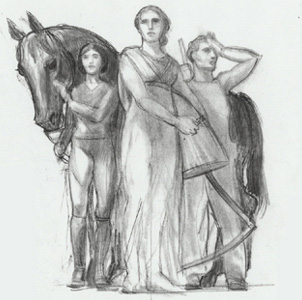 This pendentive celebrates Kentucky’s agrarian foundations with the allegorical figure Ceres, symbol of agriculture and bounty. She is flanked by a jockey and a farmer, further emblems of some of Kentucky’s most notable agrarian symbols. In the background and in the stencils, farmland, race tracks, and golden wheat indicate a bountiful harvest. The faux bas relief depicts the aboriginal, pre-western beginnings of the commonwealth.
This pendentive celebrates Kentucky’s agrarian foundations with the allegorical figure Ceres, symbol of agriculture and bounty. She is flanked by a jockey and a farmer, further emblems of some of Kentucky’s most notable agrarian symbols. In the background and in the stencils, farmland, race tracks, and golden wheat indicate a bountiful harvest. The faux bas relief depicts the aboriginal, pre-western beginnings of the commonwealth.
Pendentive 2: Industry: The Strength of Commerce
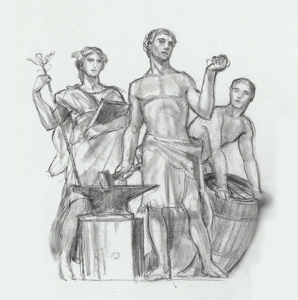 This pendentive underscores the strength and breadth of Kentucky’s commercial underpinnings. The allegorical figure Mercury (or Hermes) represents commerce and trade, and is joined by a figure moving a barrel of bourbon, a significant element of Kentucky’s economy, and a blacksmith, who signifies the commonwealth’s well‐ documented history of manual labor, craftsmanship, and industry. Other iconographical elements include a locomotive crossing the Ohio River Bridge in Louisville, the Ashland refineries lining the riverbanks, and a faux bas relief at pendentive’s base depicting a Native American Paleo-Indian period scene of the prehistory of industry.
This pendentive underscores the strength and breadth of Kentucky’s commercial underpinnings. The allegorical figure Mercury (or Hermes) represents commerce and trade, and is joined by a figure moving a barrel of bourbon, a significant element of Kentucky’s economy, and a blacksmith, who signifies the commonwealth’s well‐ documented history of manual labor, craftsmanship, and industry. Other iconographical elements include a locomotive crossing the Ohio River Bridge in Louisville, the Ashland refineries lining the riverbanks, and a faux bas relief at pendentive’s base depicting a Native American Paleo-Indian period scene of the prehistory of industry.
Pendentive 3: Culture: The Fruits of Knowledge
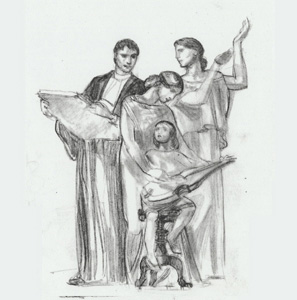 In this pendentive, the allegorical figure “Muse of the Arts” represents the tradition of music and dance, two elements intrinsic to Kentucky’s cultural heritage. The other figures of the pendentive are that of a teacher and a young girl learning to play the dulcimer, Kentucky’s state instrument, and a Jurist figure representing elements of law and instruction. The background includes elements of the Kentuckian landscape such as the Red River Gorge, and the faux bas relief at the base of the pendentive depicts Native American men from the Woodland Period at Wickliffe Mounds (in Western Kentucky) playing drums.
In this pendentive, the allegorical figure “Muse of the Arts” represents the tradition of music and dance, two elements intrinsic to Kentucky’s cultural heritage. The other figures of the pendentive are that of a teacher and a young girl learning to play the dulcimer, Kentucky’s state instrument, and a Jurist figure representing elements of law and instruction. The background includes elements of the Kentuckian landscape such as the Red River Gorge, and the faux bas relief at the base of the pendentive depicts Native American men from the Woodland Period at Wickliffe Mounds (in Western Kentucky) playing drums.
Pendentive 4: Civitas: The Light of Progress
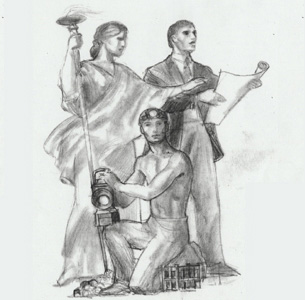 This pendentive depicts the allegorical figure Athena, the goddess of civilization, progress, and strength. She is complimented by a coalminer, a symbol of one of Kentucky’s signature industries, and a city planner, a representation of progress and enlightenment. The faux bas relief at the mural’s base portrays Native Americans in animal skins hunting along Kentucky’s Buffalo Trace. In the background, symbols of technical and municipal progress such as the Roebling Suspension Bridge, the Lincoln and Davis memorials, and others are highlighted.
This pendentive depicts the allegorical figure Athena, the goddess of civilization, progress, and strength. She is complimented by a coalminer, a symbol of one of Kentucky’s signature industries, and a city planner, a representation of progress and enlightenment. The faux bas relief at the mural’s base portrays Native Americans in animal skins hunting along Kentucky’s Buffalo Trace. In the background, symbols of technical and municipal progress such as the Roebling Suspension Bridge, the Lincoln and Davis memorials, and others are highlighted.